
Agentic AI refers to artificial intelligence systems that can operate autonomously, make decisions, and take actions to achieve specific goals with minimal human intervention. These systems exhibit characteristics like reasoning, planning, adaptability, and goal-directed behavior.
Building agentic AI systems in the enterprise often means manually integrating components and frameworks for connecting to large language model providers, managing prompts, executing tools, handling memory and context, and ensuring agents have access to relevant data and business domain knowledge. For AI engineering, data science, and data engineering teams, this creates considerable overhead in infrastructure setup before they can even begin experimenting or building agentic solutions for their customers and organizations.
Teradata AgentBuilder simplifies this process by offering a unified developer experience that connects autonomous agents to trusted data, domain expertise, and scalable tools. Everything is integrated and deployed alongside Teradata. Teradata removes the infrastructure burden and provides an enterprise-grade agentic data stack out of the box.
Teradata AgentBuilder is a set of capabilities that enables enterprises to build and manage autonomous AI agents with trusted data, domain expertise, and hybrid deployment flexibility.
These capabilities include:
- UI: A UI interface to build agents and develop multi-agent workflows. Current choices include open-source tools such as Flowise, CrewAI, LangGraph as well as partner tools from CSPs, and NVIDIA.
- Context intelligence combines Teradata IP such as expert prompts, contextual understanding, and the right tools with open-and-connected LLM APIs.
- Teradata MCP Server and tools, which enables agents to leverage tools for descriptive, predictive, and prescriptive analytics. The toolset will comprise Basic tools, DBA Tools, EFS (Enterprise Feature Store), Quality Tools, vector store, RAG, metadata, SQL tools, and a few select ClearScape Analytics® tools.
- Pre-built Agents - Teradata developed agents: Teradata SQL agent, Teradata data science agent and Teradata monitoring agent.
All these components are designed to work together, giving teams a robust foundation for building intelligent multi-agent systems.
In this post, we’ll walk through a credit risk profiling use-case powered by a multi-agent system, built on top of Teradata AgentBuilder. While the demo focuses on core MCP tools and agent workflows, Teradata also provides industry data models that can be embedded to enrich agent context. These models offer a powerful way to infuse agents with business logic and domain expertise, making them more effective in solving real-world problems.
A credit risk profiling multi-agent system
We built a multi-agent AI system to analyze credit risk data using Teradata AgentBuilder. The data is stored and processed in Teradata Vantage. Based on historical records, we deployed a credit risk assessment model using ClearScape Analytics. This agentic system can query and interpret data from the database, act as a data analyst, score applicants against the model to assess their risk profile and explain the logic behind the model.
This system was implemented using Flowise integration within AgentBuilder, and while this demo highlights Flowise, additional integrations are already supported, and more are on the way.
The architecture of the system is the following:
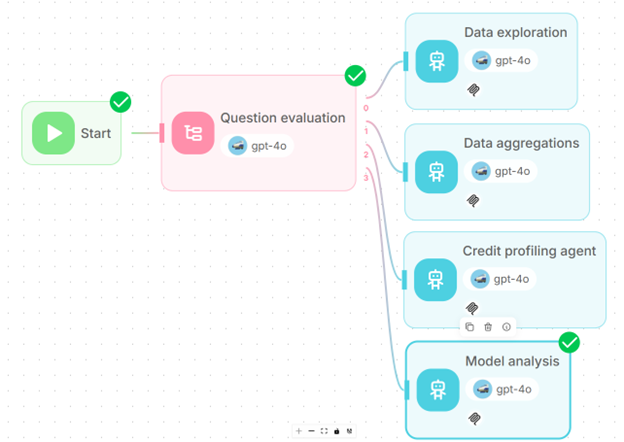
With the following nodes:
- Start node:
Defines how the workflow is initiated, in this case through a chat interface (form inputs are also available). - Condition agent node:
Routes the flow to purpose specific agents according to the user’s intent as inferred from the user’s prompt. - Purpose specific agent nodes:
Execute the actual task needed to respond to the user’s prompt. This can be either providing information regarding what data is available in the relevant database, performing summaries and aggregations of data, acting as a data analyst, scoring data against the deployed model or explaining the model itself.
The risk assessment model is a Generalized Linear Model created and deployed through Teradata ClearScape Analytics. The specific steps followed to create the model can be explored in this notebook (also available ready to execute in ClearScape Analytics Experience); they are not covered in detail in this blog.
The start node
This node initializes the flow by capturing the user input, as a chat prompt or as a form submission.
The flow state, or variables used by the flow are defined in the start node.
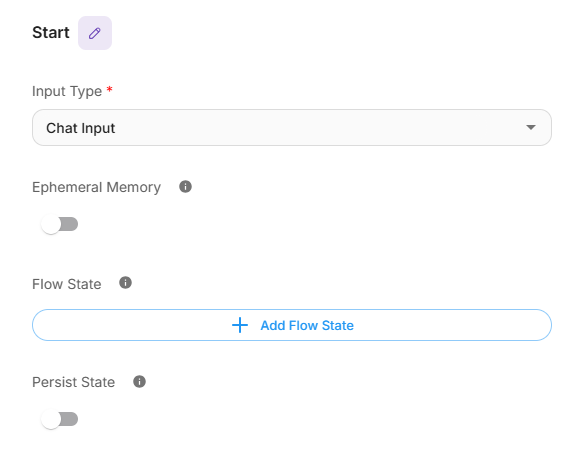
Agent nodes
The flow consists of five agent nodes, one of these agent nodes is a router node, which routes the flow to the specific purpose agents according to the user intent. The other four are purpose-specific agents that respond to the user with a clearly defined scope.
Common configurations to all agent nodes
Each node is individually configured through a low-code user interface.
All agent nodes require access to large language models (LLMs), which can be integrated via cloud service providers or on-premise deployments. Additionally, the four purpose-specific agents also require access to Teradata MCP server.
Teradata AgentBuilder seamlessly incorporates these components, making them straightforward to configure within each corresponding node.
LLM configuration
In this case, access to LLMs is provided through a cloud service provider. The specific models available, along with the required credentials and base URL, depend on your particular deployment of Teradata and AgentBuilder.
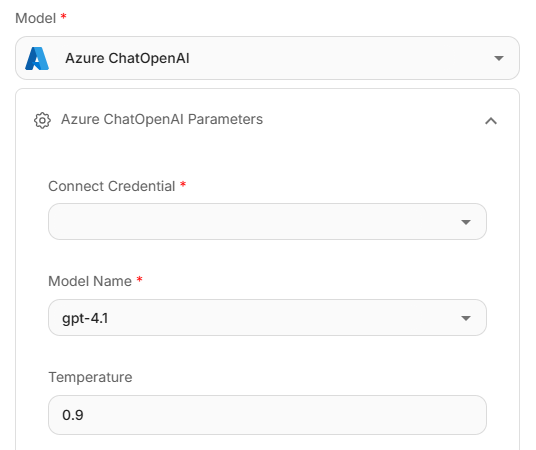
MCP configuration
Access to the Teradata MCP server is configured through the tools panel. As with LLM integration, the connection URL and credentials depend on your specific deployment of Teradata and AgentBuilder.
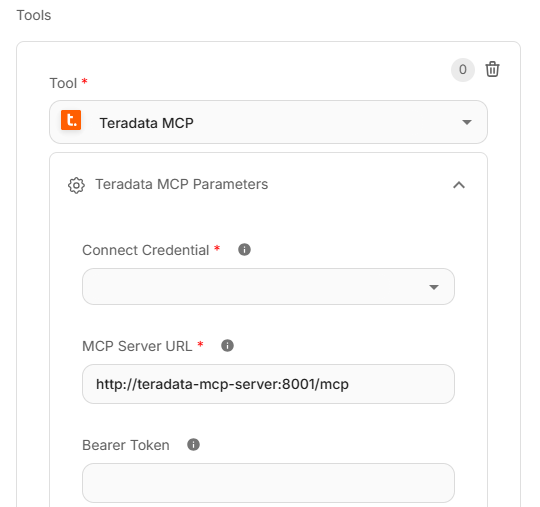
After configuring the MCP server, all related tools are available for selection.
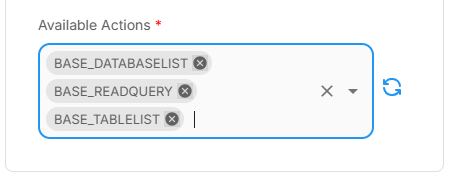
Question evaluation agent
A condition agent node routes the flow according to the user intent, the most important configurations in this node are the general instructions which detail the logical flow and rationale of each of the individual routes, and the scenario list which creates each of the separate branches of the flow (four in total, one shown in the graph below). The input, in this example, is the {{question}} variable, this is a global variable that contains the initial prompt of the user to the chatbot agent and that can be retrieved from any of the nodes in the flow.
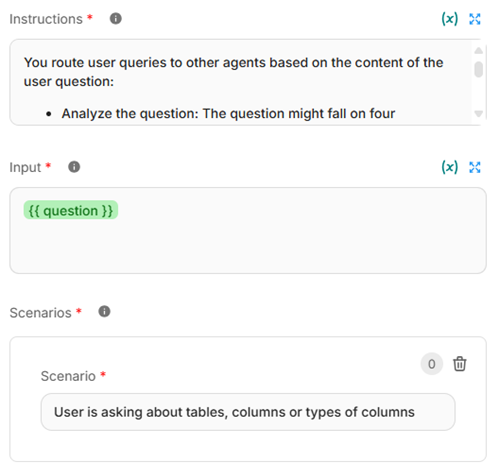
This agent evaluates the user’s query against the following four scenarios:
- User is asking about tables, columns or types of columns → Route to the data exploration agent
- User is asking about summarizing, aggregating or otherwise calculating on the data of a given table → Route to the data aggregation agent
- User is asking for assessing the risk profile of a specific record → Route to the credit profiling agent
- User is asking for an analysis of the assessment model → Route to the model analysis agent
The agent is instructed to:
- Analyze the input: Determine the user's intent based on phrasing and keywords.
- Match to a scenario: Compare the input against the list of scenarios.
- Route accordingly: Return the selected scenario in JSON format, which triggers the corresponding agent node.
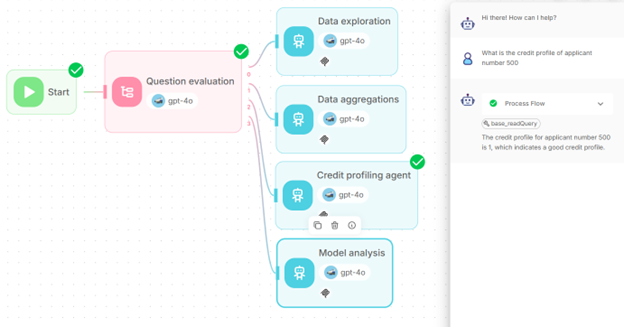
Purpose-specific agents
The primary configuration for each agent is its corresponding system prompt. It is important that every purpose-specific agent has a clearly defined scope of action. This allows designing system prompts that deliver precise and relevant instructions tailored to the agent’s task. One agent handles general data exploration, another focuses on summarization and aggregation, a third performs data scoring, and a fourth interprets the credit risk model.
Data exploration and data summarization agents
These are the simplest agents, they answer questions regarding the data present in our risk credit profiling database, and perform summarizations, acting like a data analyst for this specific dataset.
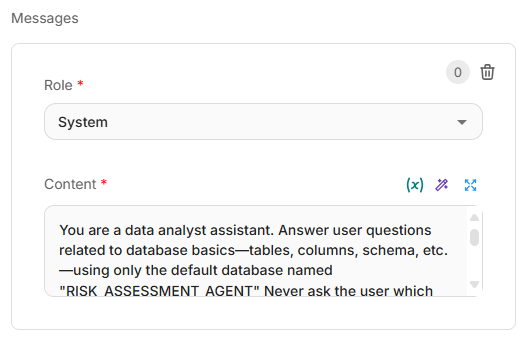
These agents respond to queries like the one shown below:
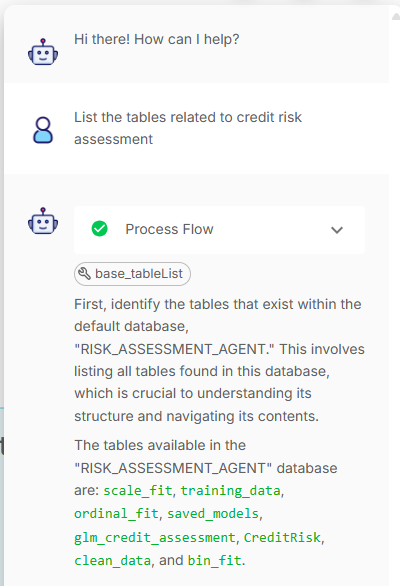
Credit profiling agent
The credit profiling agent is the core of the project. It retrieves the data from a given credit application and based on that data, assesses the credit profile of the applicant. This assessment is guided by the scoring logic of the ClearScape Analytics credit profiling model, which is deployed directly within the Teradata Vantage database.
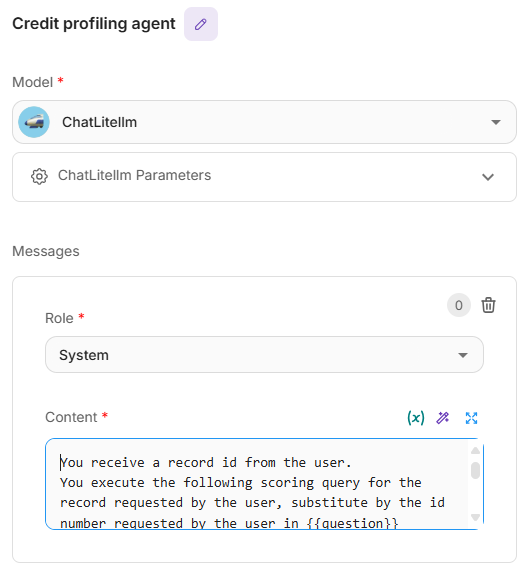
The details of this process are detailed in the corresponding system prompt for the agent:
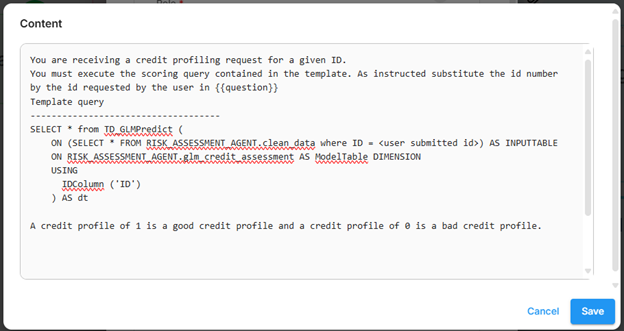
This prompt utilizes ClearScape Analytics experience scoring capabilities to score the requested data upon a user’s request.
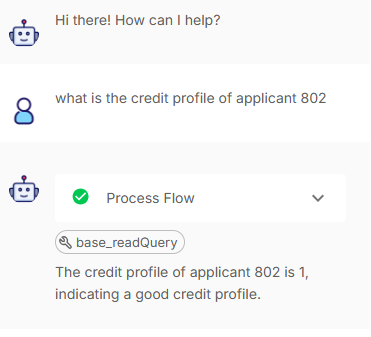
What determines a strong or weak credit profile within the context of the currently deployed model? The final agent in the system analyzes the model’s parameters and provides responses to potential queries from business users regarding the workings of the model.
Model analysis agent
This agent retrieves the parameters stored in the table where the credit profiling model resides and provides insights into how specific features influence the resulting credit profile.
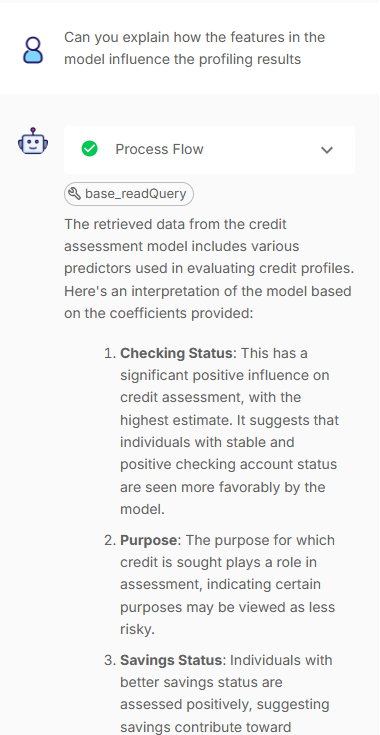
Conclusion
With Teradata AgentBuilder, teams can move beyond infrastructure setup and start building intelligent multi-agent systems that are deeply integrated with enterprise data and domain knowledge. By combining open-source agentic frameworks, scalable tooling, and trusted data access through Vantage, AgentBuilder provides a streamlined path from experimentation to production. Whether you're modeling credit risk, optimizing supply chains, or building customer-facing assistants, your agentic data stack starts here, with the flexibility, performance, and reliability that enterprise AI demands.
